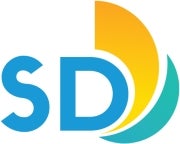
Customer Experience Strategy (CXS)
The goal of this strategy is to prioritize the customer experience for all City interactions. The needs of all people must be considered, so that no one is left behind.
Meeting people where they are is more than just an issue of consideration, it’s an issue of equity. No one wants to wait on hold for hours and some people can’t.
This document lays out a vision for customer service in three distinct sections.
- Core Values: Universal themes in our strategy.
- Guiding Principles: Our code to follow when designing or updating public services.
- Recommendations: Specific actions we can take to make this strategy a reality.
Core Values
For our services to be used by all people, they must be approachable, inviting, clear and intuitive. Digital services should be simple and easy for everyone to use.
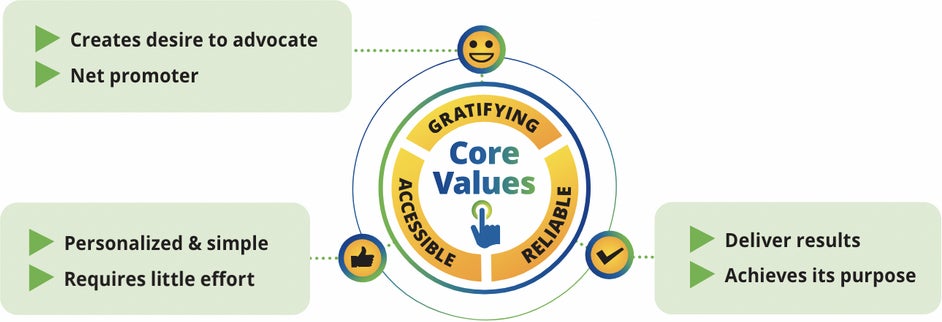
Accessible means personalized, simple, and requires little effort. Reliable means to deliver results and achieves its purpose. Gratifying creates desire to advocate and is a net promoter.
Accessible
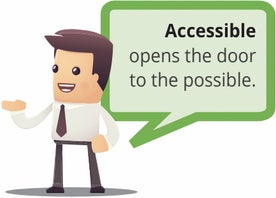
Making services accessible is the first step in engaging with all people in San Diego. Accessible services are easy to locate, approachable for everyone, and available through many different ways.
Reliable

Reliable services are essential for earning and building the trust of our customers. No matter how you are engaging or what you are seeking to do, the same high standard of service is expected and should be delivered. Reliable services also include having accurate, valid and up-to-date information available at all times.
Gratifying
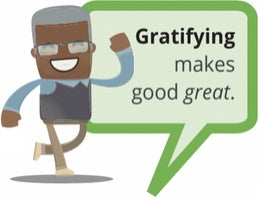
Experiences that are gratifying keep people engaged and spur a sense of accomplishment, leaving people satisfied. This value can be achieved by providing exemplary service, clear communication, transparent results and easy processes. When interacting with the City, you should feel satisfied enough to share your positive experience and become an advocate for the service.
Guiding Principles
These three statements expand on the Core Values and are meant to guide our work. Everything we do should follow these principles.
Principle #1: Put people at the center of all we do.
What is it?
Human-centered design is the gold standard for developing services that prioritize people’s needs and deliver as promised. This approach uses your input, behaviors and experiences to shape the solutions that meet your needs.
Why does the City need it?
Actively incorporating input before launching a new service lets us build processes around people, not the other way around. Creating simple, intuitive customer experiences means fewer customer service issues, more trust and transparency in the process, and less taxpayer dollars spent recovering from confusing or convoluted experiences.
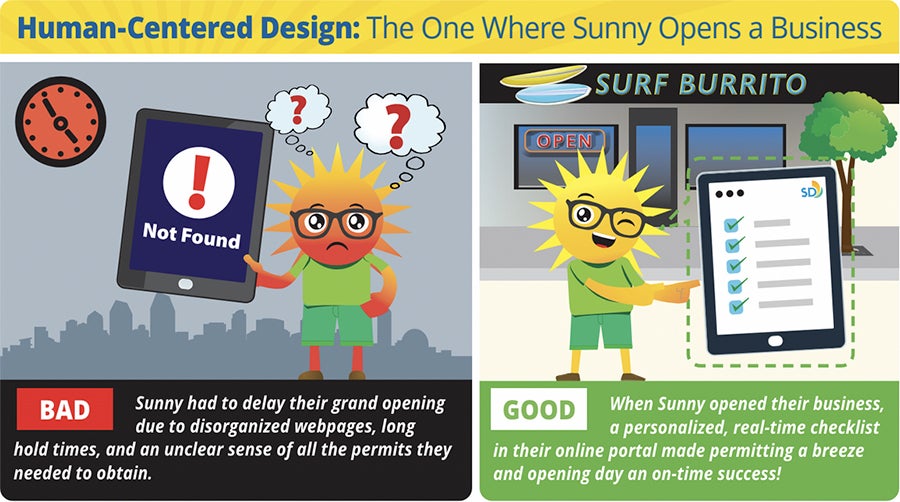
A resident of San Diego, Sunny is looking to open a new surfboard and burrito shop. Example of a bad experience: Sunny had to delay their grand opening due to disorganized webpages, long hold times, and an unclear sense of all the permits they needed to obtain. Example of a good experience: When Sunny opened for business, a personalized, real-time checklist in their online portal made permitting a breeze and opening day an on-time success!
Principle #2: Enhance the customer experience at every step.
What is it?
Every interaction is designed to make sure you are on the path to a successful journey. This means providing meaningful status updates for a service request, giving accurate time estimates for the next step, and communicating promptly and clearly when action is needed on their part. Breaking down customer experiences into specific interactions lets us examine each step under a magnifying glass to see how we can improve the overall experience — whether through technology or process upgrades.
Why does the City need it?
Enhancing services does not mean just adding a button to a website or creating a fancy new app — it involves examining how a process best works to determine what the design should be or the technology it should use.
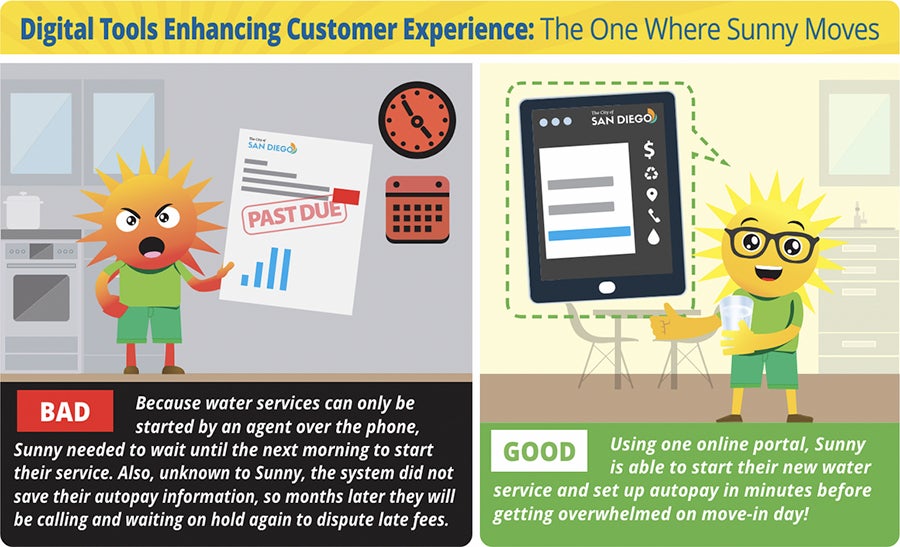
Sunny moves to a new house and remembers they need to contact the City to start their water service. Example of bad experience: Because water services can only be started by an agent over the phone, Sunny needed to wait until the next morning to start their service. Also, unknown to Sunny, the system did not save their autopay information, so months later they will be calling and waiting on hold again to dispute late fees. Example of good experience: Using one online portal, Sunny is able to start their new water service and set up autopay in minutes before getting overwhelmed on move-in day!
Principle #3: Services are smooth from start to finish.
What is it?
The best customer experiences offer a seamless start-to-finish journey; like catching a direct flight instead of a connecting one. This happens when people are guided toward their desired outcome, stops or transitions are invisible to the customer, and all touch interactions are aligned for the customer experience.
Why does the City need it?
The behind-the-scenes process directly impacts the results you see, as well as how efficiently the City can provide a service. Improving processes means breaking down departmental divides and examining the end-to-end “customer journey” necessary to complete a given task. You should be able to request any service without knowing which department is operationally responsible and have a consistent experience, regardless of who the request ultimately goes to.
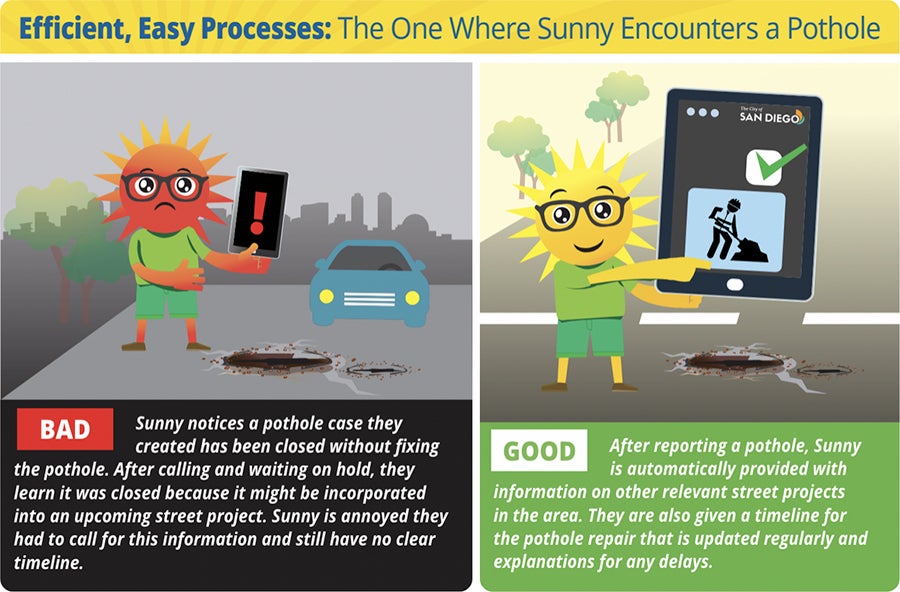
While driving home from their shop, Sunny hits a pothole and decides to report it to the City. Example of a bad experience: Sunny notices a pothole they created has been closed without fixing the pothole. After calling and waiting on hold, they learn it was closed because it might be incorporated into an upcoming street project. Sunny is annoyed they had to call for this information and still have no clear timeline. Example of good experience: After reporting a pothole, Sunny is automatically provided with information on other relevant street projects in the area. They are also given a timeline for the pothole repair that is updated regularly and explanations for any delays.
Recommendations
The City has many priorities competing for limited resources, which makes resource allocation challenging. Moving forward with these recommendations will yield a high return on investment, saving taxpayer time, frustration and money.
These recommendations are designed to build a “first line of defense” that starts to address the gap in tools needed for customers to successfully engage with the City and for employees to do their jobs.
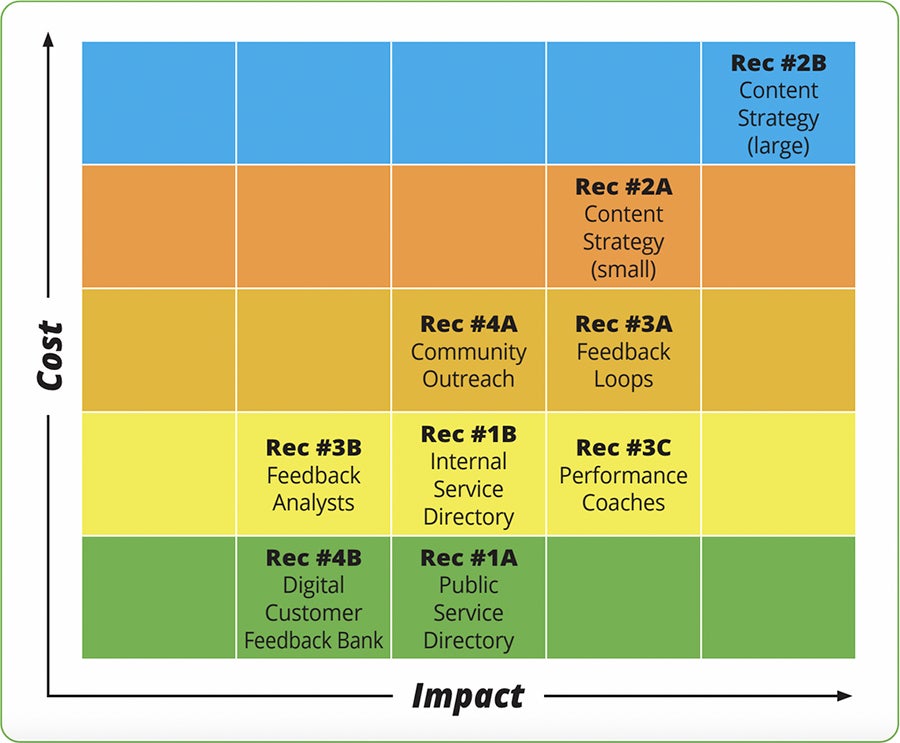
This chart outlines the recommendations on a chart that ranks the impact of each one from 1 – 5. The placements are as follows: Rec #4B Digital Customer Feedback Bank – 2/5 impact; 1/5 cost. Rec #3B Feedback Analysts – 2/5 impact; 2/5 cost. Rec #1A Public Service Directory – 3/5 impact; 1/5 cost. Rec #1B Internal Service Directory – 3/5 impact; 2/5 cost. Rec #4A Community Outreach – 3/5 impact; 3/5 cost. Rec #3C Performance Coaches – 4/5 impact; 2/5 cost. Rec #3A Feedback Loops – 4/5 impact; 3/5 cost. Rec #2A Content Strategy (small) - 4/5 impact; 4/5 cost. Rec #2B Content Strategy (large) - 5/5 impact; 5/5 cost.
Recommendation #1:
Publish a public, searchable directory of City services.
This recommendation, available as a smaller and larger project, would provide a one-stop shop for people interested in engaging with the City but unsure where to go, how to do it, or for what exactly they’re looking.
1A Public Service Directory
Building a public-facing service directory is the first tangible action in this strategy. This public directory will become a centerpiece of the City’s website and include key information on how to access the service (e.g. the channels the service is offered on, where to start the process, hours of operation, etc.).
1B Internal Service Directory
In addition to the public version of the directory, we recommend collecting and maintaining a more extensive internal directory to help us prioritize projects that have the potential to make the most public impact for the least cost. The efficiencies gained from this new resource means more people helped, shorter response times, higher customer satisfaction and money saved!
Recommendation #2:
Update our content standards to ensure everything we publish is accurate, approachable, and up to date.
FUN FACT: The City’s digital front door, sandiego.gov, gets around 30 million hits a year!
When information is correct and readily available, would-be calls are deflected and those that get through are handled quickly and accurately by agents with access to quality information. Given the expanse of our digital content, we have developed both a smaller and larger scope recommendation:
2A Use Service Directory to Identify and Fix High-Volume, Low-Quality Content
The service directory developed in Recommendation 1B will act as a guide to identify high-impact, key areas to improve. Ultimately, we would deliver validated content supported by a new structure that will allow us to review, refine and maintain future information.
2B Full-scale Content Management
A more robust effort would commit the City to reviewing and validating all of our individual webpages. In addition to just reviewing the content, we would also examine the structure and design of the website itself.
Recommendation #3:
Use feedback to make improvements.
Without feedback, the City wouldn’t know how we’re performing, or worse, we may be ignoring the voice of the people. We need a method to systematically improve services and act on feedback.
3A Create Feedback Loops For All Services
A feedback loop is a way for you to share their experience with the people providing it. Although some services already have feedback loops, there are many without one. A formal feedback mechanism is crucial to accurately and comprehensively understand if our services are satisfying customers.
3B Start a CX Analysis Program
While the first step is to gather information, the second step is to analyze and identify trends, root causes and areas of improvement. This step turns raw data into something actionable. A team of CX analysts is necessary to own the data, systematically analyze it, discover insights, and highlight where we need improvement.
3C Use Performance Coaches to Drive Improvements
Departments need change agents to help drive improvements. The final step is to turn the CX analysis into action, making actual process changes and improving the overall experience in sustainable and repeatable ways. By following the Lean Six Sigma DMAIC framework, the industry standard for change management and process improvement, performance coaches would work closely with departments to make improvements based on the insights learned from customer feedback by the CX analysts.
Recommendation #4:
Make space to hear from all voices – loud and soft.
To create solutions that serve people, it’s critical to talk directly with people. This recommendation builds a foundation to:
- Reach out to meet people where they are.
- Collect customer input and thoughts.
- Organize people’s feedback for analysts (Recommendation #3B) to make tangible improvements.
4A Meet People Where They Are … Literally
To raise awareness of all the City has to offer and ensure equitable service delivery, we need to form a team of City personnel to uplift the voices of our communities. As part of this effort, the team will attend and host local events, working hand-in-hand with communities to educate people on the many digital resources the City offers and how to access them.
4B Create Ways for People to Engage and Provide Direct Feedback
Customers are eager to provide feedback about City services, forms and content. To harness this energy in our community, we need a way to allow individuals to voluntarily participate in future surveys, user testing, focus groups or other feedback opportunities. By building a bank of eager customers ready to let us know their thoughts, we will be better equipped to tweak and tailor digital services before they go live, reducing time spent recovering from failures that could have been easily prevented had we just asked.
Methodology
In 2023, the Performance and Analytics Department (PandA) embarked on our journey to create a cohesive strategy that would uplift and standardize the customer experience (CX) across all City of San Diego services.
Prior to presenting our initial draft to the Audit Committee in June 2023, we relied heavily on secondary research to develop the foundation for our strategy. In this stage, we used prominent examples of intentional customer service strategies to inform our approach. This included England’s NHS, VA.gov, as well as the City of San Francisco and State of Colorado for examples of best practices within governing bodies.
A core tenet of our strategy is to be responsive to the feedback of our customers. So, to “practice what we preach,” the PandA team presented an outline of the proposed strategy at community meetings in each of the City’s nine Council Districts to collect feedback on how to improve our first draft. Additionally, PandA hosted a citywide virtual session for those unable to attend the in-person Council District meetings, created an online survey, and presented to the City’s unclassified workforce. The full draft (in English and Spanish) was also posted to sandiego.gov/digitalcx for feedback.
During this time, PandA staff also attended community events to distribute informational materials on the strategy and offered internal briefings to department heads and other members of the City’s executive leadership team. Following the conclusion of this formal outreach effort, which ran from October – December 2023, PandA incorporated the feedback and reshared the revised strategy with digital strategists and City officials for additional review.
Through these efforts, we were able to present and receive input from over 620 individuals.
This project would not be possible without thoughtful contributions from many individuals, departments and groups, including support and feedback from:
- Participants in the Digital Customer Experience Survey (English and Spanish)
- Participants in the Citywide Digital Customer Experience Overview Webinar
- Eastern Area Communities Planning Committee
- City Heights Community Planning Committee
- La Jolla Community Planning Association
- Listening Session (Council District 5)
- Ocean Beach Town Council
- San Ysidro Community Planning Group
- Tierrasanta Planning Group
- University City Planning Group
- Uptown Planners
- Mayor Todd Gloria
- Chief Operating Officer Eric Dargan
- Chief Financial Officer Matt Vespi
- Councilmember Joe LaCava
- Councilmember Jennifer Campbell
- Councilmember Stephen Whitburn
- Councilmember Henry Foster III
- Councilmember Marni von Wilpert
- Councilmember Kent Lee
- Councilmember Raul Campillo
- Councilmember Vivian Moreno
- Council President Sean Elo-Rivera
- Former Councilmember Monica Montgomery Steppe
- City Attorney Mara Elliott
- Independent Budget Analyst Charles Modica
- City Auditor Andy Hanau
- City Audit Committee
- City Rules Committee
- City executive leadership
- Communications Department
- Amor F. Figuracion, Graphic Design
- Jennifer McBride, Public Information Officer
- Leslie Wolf Branscomb, Public Information Officer
- Ron Vazquez, Web Services Manager
- Kara Fitzpatrick, volunteer
- Moriah Gaynor, Performance & Analytics
- Marcus Lostracco, Performance & Analytics
- Angela Wells, Performance & Analytics
Learn More
- Digital Customer Experience (DCX) Strategy DRAFT
- Experiencia Digital del Cliente (DCX) Estrategia BORRADOR
- Share Your Feedback! | Comparta Sus Comentarios
Community Input Meetings Schedule
Tuesday, Oct. 10, 2023
University City Planning Group (UCPG)
6 p.m. hybrid (Zoom / 9880 Campus Pointe Dr. in 3rd floor Terra Nova room)
Wednesday, Oct. 11, 2023
San Ysidro Planning Group
5:30 p.m. at San Ysidro School District Education Center Board Room
Wednesday, Oct. 18, 2023
Tierrasanta Community Council and Planning Group
6:30 p.m. at Tierrasanta Recreation Center
Tuesday, Oct. 24, 2023
Council District 5 DCX Information Session
6 p.m. at Ed Brown Center
Wednesday, Oct. 25, 2023
Ocean Beach Town Council
7 p.m. at Point Loma Library
Tuesday, Nov. 7, 2023
Uptown Planners
6 p.m. at Joyce Beers Community Center
Tuesday, Nov. 14, 2023
Citywide Digital Information Session
6 p.m. on Zoom (https://sandiego.zoomgov.com/j/1619464789)
Eastern Area Communities Planning Committee
7 p.m. at Teen Challenge
